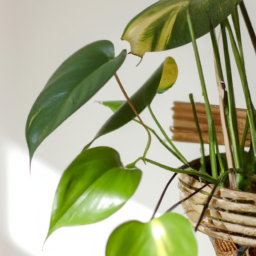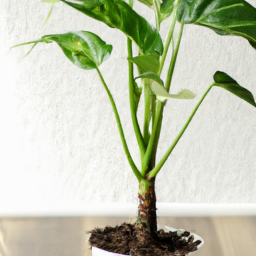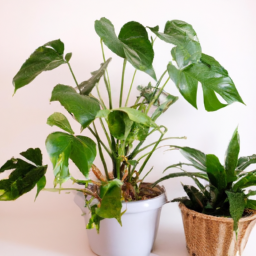
Are you looking to add some greenery to your indoor space but not sure where to start? Well, you’ve come to the right place! Today, we’re going to explore the wonderful world of types of indoor house plants. Whether you’re a seasoned plant parent or a complete newbie, there’s a perfect plant out there for you. From low-maintenance succulents to air-purifying peace lilies, we’ll cover all the different types of indoor plants that can thrive in your home. So, grab your watering can and let’s get started on creating your own indoor jungle!
Benefits of Different Types of Indoor House Plants
Improving Air Quality
Indoor house plants are not just decorative, they also play a crucial role in improving the air quality inside your home. Plants have the amazing ability to absorb harmful toxins such as formaldehyde, benzene, and trichloroethylene from the air, releasing oxygen in return. This can help reduce the risk of respiratory problems, headaches, and fatigue caused by poor indoor air quality.
Some of the best plants for improving air quality include the spider plant, peace lily, and snake plant. These plants are known for their ability to purify the air and create a healthier living environment for you and your family.
In addition to removing toxins from the air, indoor house plants also help increase humidity levels, which can be beneficial for those suffering from dry skin, allergies, or respiratory issues. By adding a few plants to your indoor space, you can create a more comfortable and healthier living environment.
Reducing Stress and Boosting Mood
Indoor house plants have been shown to have a positive impact on mental health by reducing stress and boosting mood. Studies have found that being around plants can help lower cortisol levels, the hormone responsible for stress, and increase serotonin levels, the hormone that promotes feelings of happiness and well-being.
Plants have a calming effect on the mind and body, making them a great addition to any indoor space. Whether you choose a lush green fern or a colorful flowering plant, having plants around can help create a sense of tranquility and relaxation in your home.
In addition to reducing stress, indoor house plants can also improve concentration and productivity. The presence of plants in your workspace or study area can help increase focus and creativity, making you more efficient and effective in your tasks.
Purifying the Air and Enhancing Décor
Indoor house plants not only purify the air and improve your health, but they also add beauty and style to your home décor. Plants come in a wide variety of shapes, sizes, and colors, making it easy to find the perfect plant to complement your interior design style.
Whether you prefer a sleek and modern look or a cozy and bohemian vibe, there is a plant out there that will suit your taste. From tall and leafy palms to small and delicate succulents, indoor house plants can add a touch of nature and freshness to any room in your home.
In addition to their aesthetic appeal, indoor house plants also have the ability to absorb sound and reduce noise levels in your home. This can create a more peaceful and serene environment, perfect for relaxing and unwinding after a long day.

Popular Types of Indoor House Plants and How to Care for Them
1. Succulents
Succulents are a trendy choice for indoor house plants due to their unique shapes and low maintenance requirements. These plants come in a variety of shapes and sizes, making them versatile for any indoor space. Some popular types of succulents include aloe vera, echeveria, and jade plants.
To care for succulents, it’s important to provide them with plenty of sunlight. Place them near a sunny window where they can receive at least 6 hours of sunlight per day. Watering succulents can be tricky, as they prefer to dry out between waterings. It’s best to water them deeply but infrequently, allowing the soil to completely dry out before watering again.
Another important aspect of succulent care is the type of soil they are planted in. Succulents require well-draining soil to prevent root rot. You can use a cactus or succulent mix, or create your own by mixing potting soil with perlite or sand.
Overall, succulents are a great choice for indoor house plants due to their unique appearance and low maintenance needs. With the right care, they can thrive in any indoor space.
2. Ferns
Ferns are a popular choice for indoor house plants due to their lush, green foliage and air-purifying properties. There are many different types of ferns to choose from, such as Boston ferns, maidenhair ferns, and bird’s nest ferns. These plants thrive in humid environments, making them a great choice for bathrooms or kitchens.
To care for ferns, it’s important to keep the soil consistently moist but not waterlogged. Water them when the top inch of soil feels dry to the touch, and mist them regularly to increase humidity levels. Ferns also prefer indirect sunlight, so place them in a location where they can receive filtered light throughout the day.
Ferns are relatively low maintenance plants, but they do require regular pruning to remove dead or yellowing fronds. This will help the plant maintain its lush appearance and encourage new growth. Overall, ferns are a great choice for indoor house plants due to their beauty and air-purifying properties.
3. Snake Plants
Snake plants, also known as mother-in-law’s tongue, are a popular choice for indoor house plants due to their unique appearance and air-purifying properties. These plants have tall, sword-shaped leaves that can add a touch of drama to any indoor space. Snake plants are also known for their ability to filter toxins from the air, making them a great choice for bedrooms or offices.
To care for snake plants, it’s important to place them in indirect sunlight. These plants can tolerate low light conditions, making them a versatile choice for any indoor space. Water snake plants sparingly, allowing the soil to dry out between waterings. Overwatering can lead to root rot, so it’s best to err on the side of underwatering with these plants.
Snake plants are relatively low maintenance, but they do benefit from occasional fertilization during the growing season. Use a balanced houseplant fertilizer once a month to encourage healthy growth. With the right care, snake plants can thrive indoors for many years to come.
In conclusion, there are many different types of indoor house plants to choose from, each with their own unique care requirements. Whether you prefer succulents, ferns, or snake plants, there is a plant out there for every indoor space. By following these care tips, you can ensure that your indoor plants thrive and bring beauty to your home.

Choosing the Right Types of Indoor House Plants for Your Home
When it comes to choosing the right types of indoor house plants for your home, there are a few key factors to consider. From the amount of sunlight your space receives to the level of care you are willing to provide, finding the perfect plants for your indoor environment can be a fun and rewarding process. In this guide, we will explore some of the most popular types of indoor house plants and provide tips on how to care for them effectively.
1. Consider the Lighting in Your Home
One of the most important factors to consider when choosing indoor house plants is the amount of natural light that your space receives. Some plants thrive in bright, direct sunlight, while others prefer low-light conditions. Before selecting your plants, take note of the lighting in each room of your home and choose plants that are well-suited to those conditions.
If your home receives plenty of natural light, consider adding plants like succulents, cacti, and spider plants to your indoor garden. These plants thrive in bright, indirect sunlight and are relatively low-maintenance. On the other hand, if your space is on the darker side, opt for plants like peace lilies, pothos, and snake plants, which can thrive in low-light conditions.
When placing your plants in your home, be sure to rotate them regularly to ensure that they receive an even amount of sunlight on all sides. This will help prevent your plants from becoming lopsided or leaning towards the light source.
2. Choose Plants That Fit Your Lifestyle
Another important factor to consider when choosing indoor house plants is your lifestyle and the amount of time you are willing to dedicate to plant care. Some plants require frequent watering and pruning, while others are more forgiving and can thrive with minimal attention.
If you have a busy schedule or travel frequently, opt for low-maintenance plants like ZZ plants, snake plants, and pothos, which require minimal watering and can thrive in a variety of conditions. These plants are perfect for beginners or those who are new to indoor gardening.
On the other hand, if you have a green thumb and enjoy spending time caring for your plants, consider adding more high-maintenance plants like orchids, ferns, and fiddle leaf figs to your indoor garden. These plants require more attention and specific care instructions, but can be incredibly rewarding to grow and nurture.
3. Consider the Size and Placement of Your Plants
When choosing indoor house plants, it is important to consider the size and placement of your plants in your home. Some plants, like fiddle leaf figs and monstera deliciosa, can grow quite large over time and may require more space to thrive. Make sure to choose plants that fit the size of your space and consider how they will grow and spread over time.
Additionally, consider the placement of your plants within your home. Some plants, like ferns and peace lilies, thrive in humid environments like bathrooms or kitchens, while others, like succulents and cacti, prefer drier conditions. Be sure to place your plants in areas of your home where they will receive the appropriate amount of light and humidity to thrive.
By considering the lighting in your home, choosing plants that fit your lifestyle, and carefully considering the size and placement of your plants, you can create a beautiful and thriving indoor garden that will bring joy and beauty to your home for years to come. Happy planting!
Essential Points
If you’re looking to bring some greenery into your home, indoor house plants are the perfect solution. There are so many different types to choose from, each with its own unique characteristics and care requirements. Some popular options include succulents, which are known for their low maintenance and ability to thrive in dry conditions. They come in a variety of shapes and sizes, making them a versatile choice for any space.
Another popular option is the fiddle leaf fig, a statement plant with large, glossy leaves that can add a touch of elegance to any room. If you’re looking for something a little more unusual, consider a snake plant, which has striking vertical leaves that can add a modern touch to your decor. No matter what type of indoor house plant you choose, be sure to research its specific care needs to ensure it thrives in your home. With the right care and attention, indoor house plants can bring beauty and life to any space.
Frequently Asked Questions from our readers:
Q1: What are some low-maintenance indoor house plants?
A1: Some low-maintenance indoor house plants include snake plants, pothos, spider plants, and peace lilies. These plants require minimal watering and can thrive in various lighting conditions.
Q2: What are some indoor house plants that are safe for pets?
A2: Pet-friendly indoor house plants include spider plants, Boston ferns, African violets, and bamboo palms. These plants are non-toxic to cats and dogs, making them a safe choice for pet owners.
Q3: What are some indoor house plants that can purify the air?
A3: Indoor house plants that can purify the air include peace lilies, spider plants, snake plants, and rubber plants. These plants are known for their ability to remove toxins from the air, creating a healthier indoor environment.
Q4: What are some indoor house plants that thrive in low light conditions?
A4: Indoor house plants that thrive in low light conditions include ZZ plants, pothos, snake plants, and Chinese evergreens. These plants can still grow and thrive with minimal sunlight, making them perfect for rooms with limited natural light.
Q5: What are some indoor house plants that are easy to propagate?
A5: Indoor house plants that are easy to propagate include pothos, spider plants, snake plants, and succulents. These plants can be propagated through cuttings or division, making it simple to grow new plants from existing ones.
Dr. Olivia Green is a botanist with over two decades of experience in indoor plant cultivation. She holds a Ph.D. in Plant Biology and has dedicated her career to researching plant behavior in controlled environments. Dr. Green is passionate about helping plant enthusiasts master the art of indoor gardening through her extensive knowledge and practical insights.


